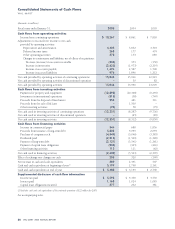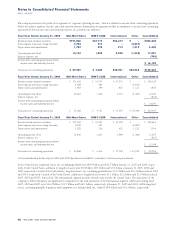Walmart 2005 Annual Report Download - page 47
Download and view the complete annual report
Please find page 47 of the 2005 Walmart annual report below. You can navigate through the pages in the report by either clicking on the pages listed below, or by using the keyword search tool below to find specific information within the annual report. WAL-MART 2005 ANNUAL REPORT 45
The total intrinsic value of options exercised in fiscal 2005, 2004
and 2003 was $236 million, $251 million and $252 million,
respectively. The income tax benefit resulting from the tax deduc-
tions triggered by employee exercise of stock options amounted to
$78 million, $83 million and $84 million in fiscal 2005, 2004
and 2003, respectively.
The company issues restricted (non-vested) stock to certain
associates which vests based on passage of time. Restricted stock
awards are not included in the preceding tables. Restricted stock
awards generally vest 25 percent after three years, 25 percent after
five years and 50 percent at age 65. At January 31, 2005, 3 million
restricted stock shares with vesting based on the passage of time
were outstanding, with a weighted-average grant date value of $46.63.
The company issues stock-based awards for which vesting is tied
to the achievement of performance criteria. These awards accrue
to the associate based on the extent to which revenue growth and
return on investment goals are attained or exceeded over a three-
year period. Based on the extent to which the targets are achieved,
vested shares may range from 0% to 150% of the original award
amount. At January 31, 2005, awards representing 1.7 million
shares were outstanding with a weighted-average grant date
value of $53.15 per share. These awards are not included in the
preceding table.
8 Litigation
The company is involved in a number of legal proceedings, which
include consumer, employment, tort and other litigation. The law-
suits discussed below, if decided adversely to or settled by the
company, may result in liability material to the company’s finan-
cial condition or results of operations. The company may enter
into discussions regarding settlement of these and other lawsuits,
and may enter into settlement agreements, if it believes settlement
is in the best interests of the company’s shareholders. In accor-
dance with Statement of Financial Accounting Standards No. 5,
“Accounting for Contingencies,” the company has made accruals
with respect to these lawsuits, where appropriate, which are
reflected in the company’s consolidated financial statements.
The company is a defendant in numerous cases containing
class-action allegations in which the plaintiffs have brought claims
under the Fair Labor Standards Act (“FLSA”), corresponding state
statutes, or other laws. The plaintiffs in these lawsuits are current
and former hourly associates who allege, among other things, that
the company forced them to work “off the clock” and failed to
provide work breaks. The complaints generally seek unspecified
monetary damages, injunctive relief, or both. Class certification
has yet to be addressed in a majority of the cases. Class certifica-
tion has been denied or overturned in Arizona, Arkansas, Florida,
Georgia, Indiana, Louisiana, Maryland, Michigan, North Carolina,
Ohio, Texas (state court), West Virginia, and Wisconsin. Some or
all of the requested classes have been certified in California,
Colorado, Massachusetts, Minnesota, Oregon, and Washington.
Conditional certifications for notice purposes under the FLSA
have been allowed in Georgia, Michigan, and Texas (federal court).
A putative class action is pending in California challenging the
methodology of payments made under various associate incentive
bonus plans, and a second putative class action in California
asserts that the company has omitted to include bonus payments
in calculating associates’ regular rate of pay for purposes of deter-
mining overtime.
The company is currently a defendant in four putative class actions
brought on behalf of assistant store managers who challenge their
exempt status under the FLSA, which are pending in federal courts
in Michigan, New Mexico, and Tennessee. A similar putative class
action challenging the exempt status of Wal-Mart assistant store
managers under California law has been filed in Los Angeles
County Superior Court. No determination has been made as to
class certification in any of these cases.
The company is a defendant in Dukes v. Wal-Mart Stores, Inc., a class-
action lawsuit commenced in June 2001 and pending in the United
States District Court for the Northern District of California. The case
was brought on behalf of all past and present female employees in all
of the company’s retail stores and wholesale clubs in the United
States. The complaint alleges that the company has engaged in a pat-
tern and practice of discriminating against women in promotions, pay,
training and job assignments. The complaint seeks, among other
things, injunctive relief, front pay, back pay, punitive damages, and
attorneys’ fees. Following a hearing on class certification on
September 24, 2003, on June 21, 2004, the District Court issued an
order granting in part and denying in part the plaintiffs’ motion for
class certification. The class, which was certified by the District
Court for purposes of liability, injunctive and declaratory relief, puni-
tive damages, and lost pay, subject to certain exceptions, includes all
women employed at any Wal-Mart domestic retail store at any time
since December 26, 1998, who have been or may be subjected to
the pay and management track promotions policies and practices
challenged by the plaintiffs. The class as certified currently includes
approximately 1.6 million present and former female associates.
The company believes that the District Court’s ruling is incorrect.
The United States Court of Appeals for the Ninth Circuit has granted
the company’s petition for discretionary review of the ruling. If the
company is not successful in its appeal of class certification, or an
appellate court issues a ruling that allows for the certification of a
class or classes with a different size or scope, and if there is a sub-
sequent adverse verdict on the merits from which there is no suc-
cessful appeal, or in the event of a negotiated settlement of the
litigation, the resulting liability could be material to the company.
The plaintiffs also seek punitive damages which, if awarded, could
result in the payment of additional amounts material to the company.
However, because of the uncertainty of the outcome of the appeal
from the District Court’s certification decision, because of the
uncertainty of the balance of the proceedings contemplated by the
District Court, and because the company’s liability, if any, arising
from the litigation, including the size of any damages award if
plaintiffs are successful in the litigation or any negotiated settlement,
could vary widely, the company cannot reasonably estimate the
possible loss or range of loss which may arise from the litigation.
























